
Clarity and consistency are the building blocks of great content.
When your writing is crisp, clear, and easy to understand,
audiences will likely leave your site with a positive impression.
Unfortunately, many brands forego
style guides and choose to wing it instead. While not necessarily a fatal mistake by any means, it does often lead to content that looks sloppy.
Without guidelines to enforce consistency, it’s easy to allow your content to become a formatting free-for-all where commas roam free, and nothing follows a clear logic. The results leave your blog or website looking at the Wild West of basic grammatical conventions.
If this sounds hyperbolic, consider this:
newspapers are written to be effortless to read. Concise writing and consistent style go a long way toward achieving this goal. There’s a reason why your daily paper sounds how it does; it’s designed that way to be effective.
Does your content need to be perfect to be effective? Not nearly, no. But everything you can do to enforce consistency and clarity will help your cause. Here is a cheat sheet based on the updated
2023-2024 version of the Associated Press Stylebook.
Recommended: Website Citation Generator
Basics Of AP Style
What Is AP Style?
The Associated Press Stylebook and Briefing on Media Law is the official style guide of the Associated Press, a not-for-profit news agency that’s been around since 1846. News organizations, magazines, and web publications often use these guidelines, but brands also form the basis of their individual style guides from this structure.
The official Associated Press style guide gets updated year to year.
Arguably, these changes have led to bloat. Detractors say the guide is excessively detailed, beyond the point of being necessary or even helpful. If following this style is vital to your situation, consider buying the official version. It’s available in both digital and hard copies.
NOTE: It’s important not to confuse AP style with APA style.
Who Uses AP Style?
Journalists generally use the Associated Press style but aren’t alone in using it. Here’s a short list of folks who might need to get familiar with it:
- Journalists
- Editors
- PR Professionals
- Marketers
Numbers & Numerals In AP Style
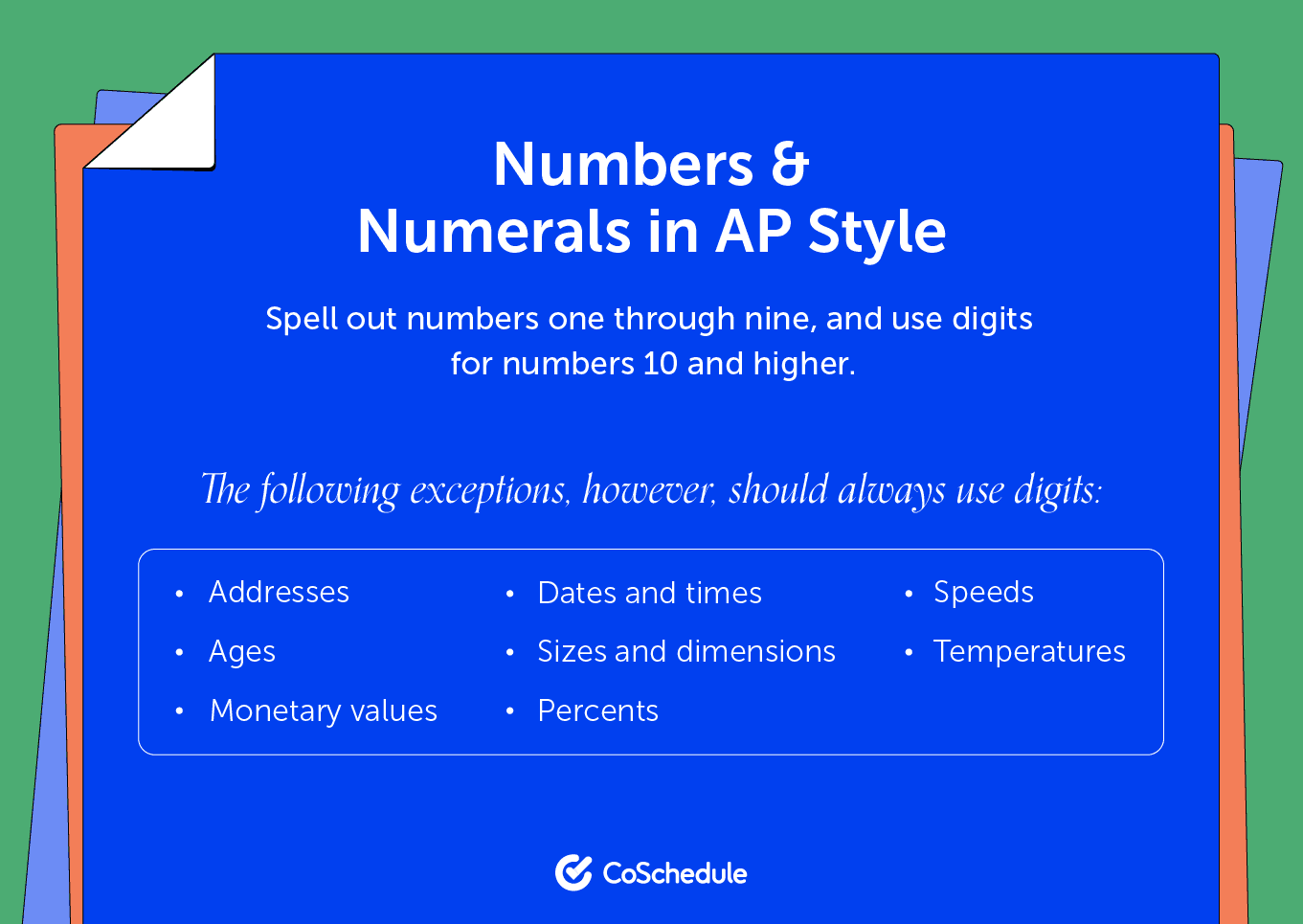
Press Release Datelines
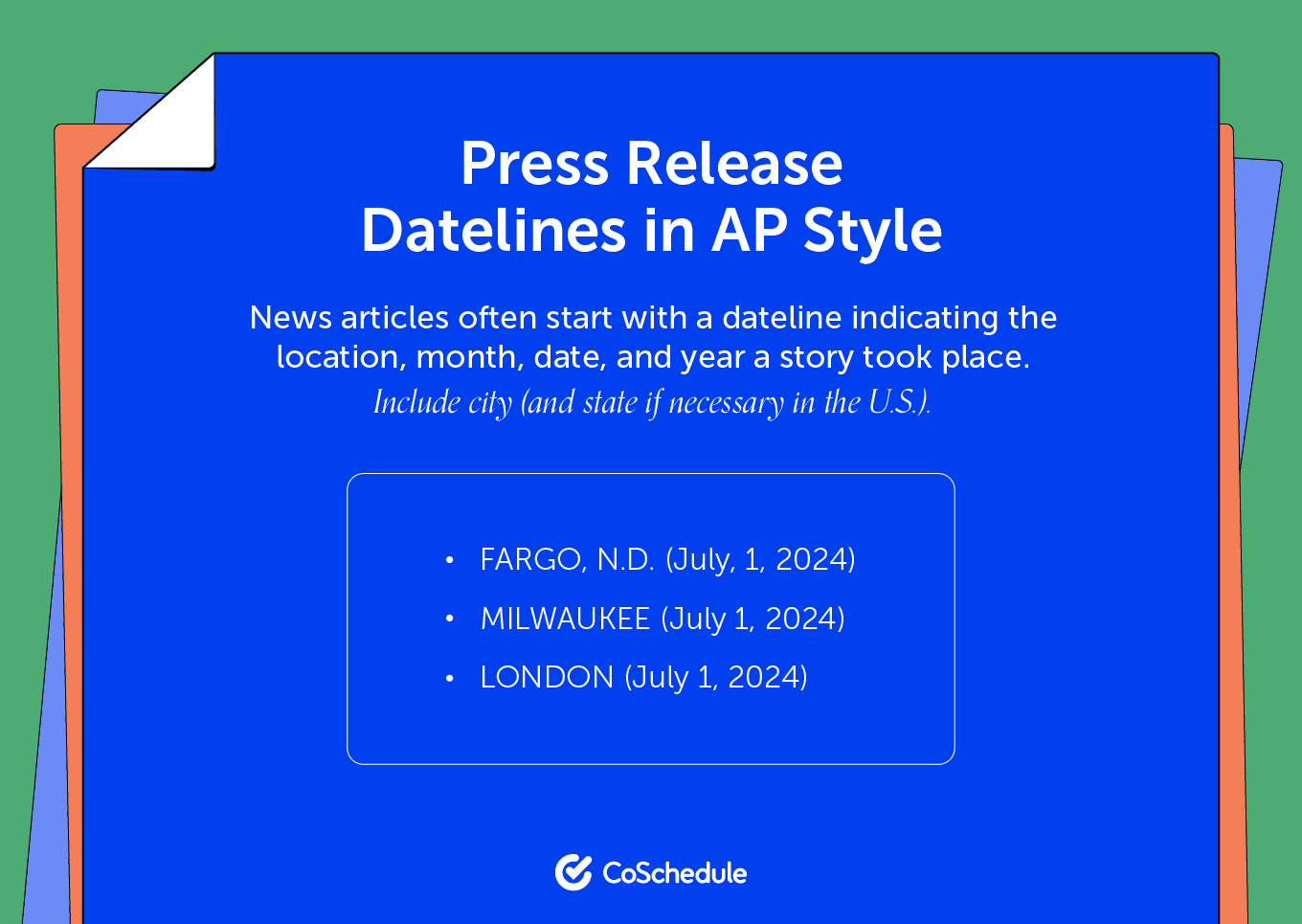
Months, Days, & Times
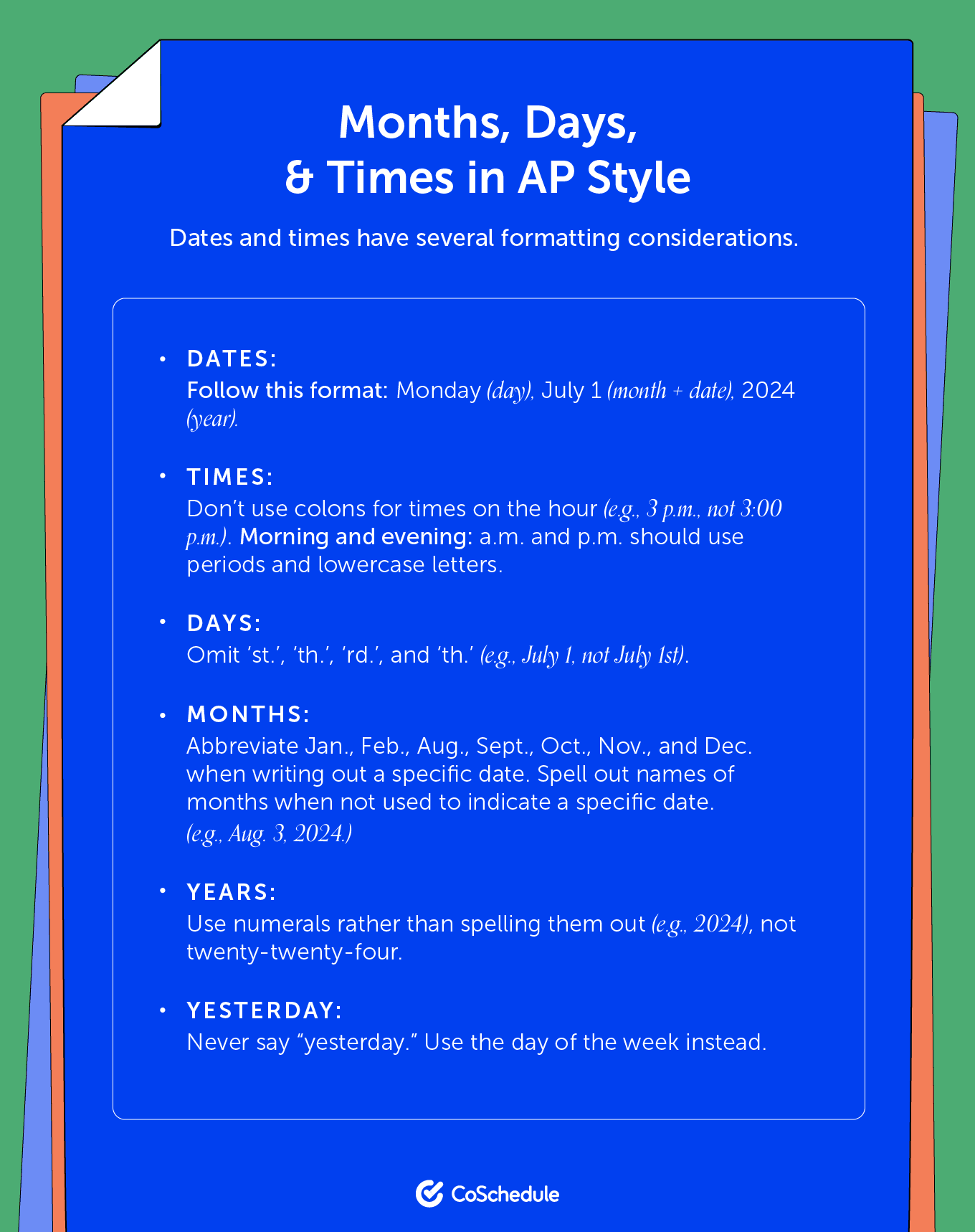
Years (Starting Sentences With Years)
Avoid starting sentences with a number unless referencing a year (e.g., 1977 was the last year the Minnesota Vikings went to the Super Bowl).
Ages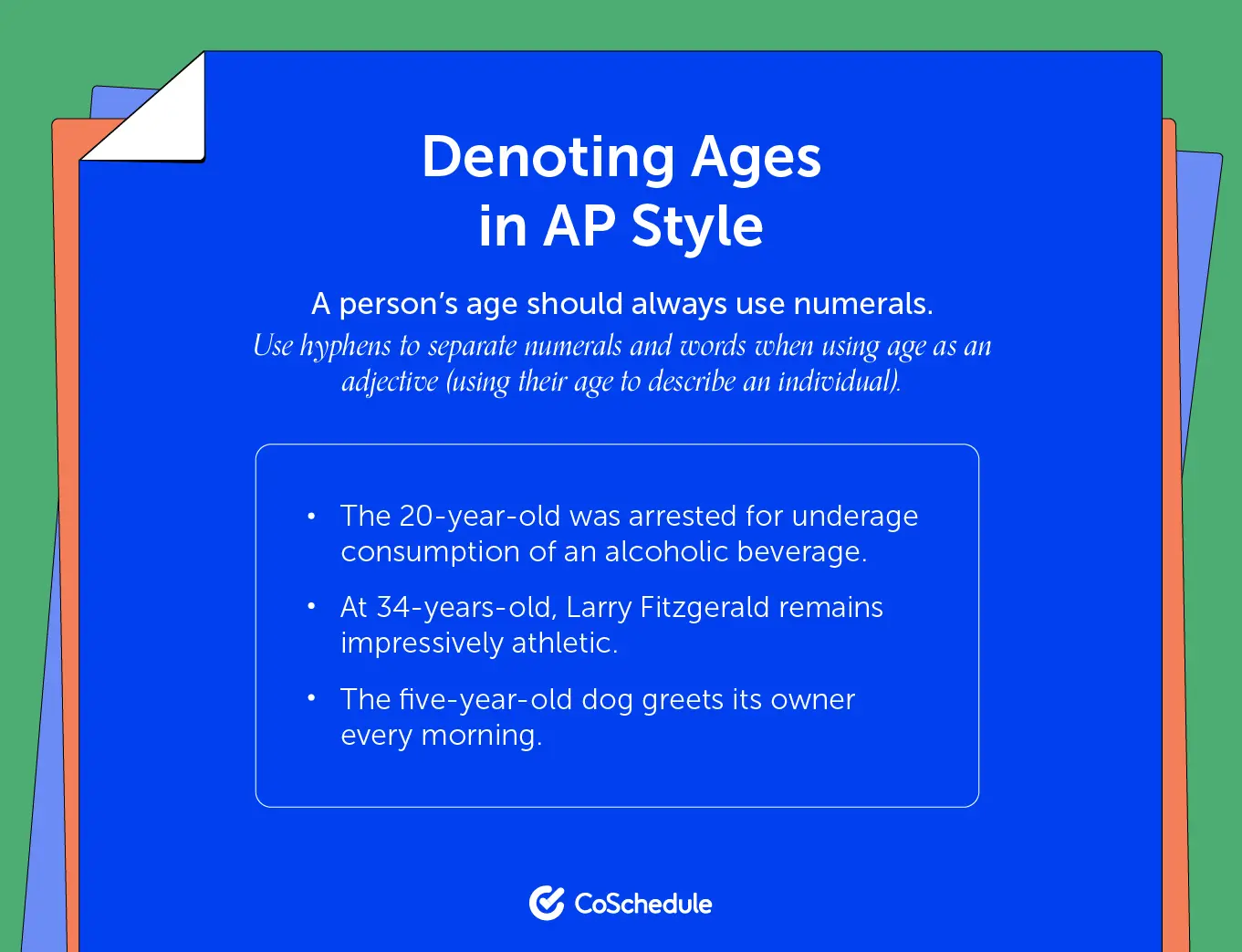
Roman Numerals
Use Roman numerals when referring to a sequence of events or people.
Examples:
- Super Bowl XLV
- Queen Elizabeth II
- World War I
Sizes, Dimensions, & Distances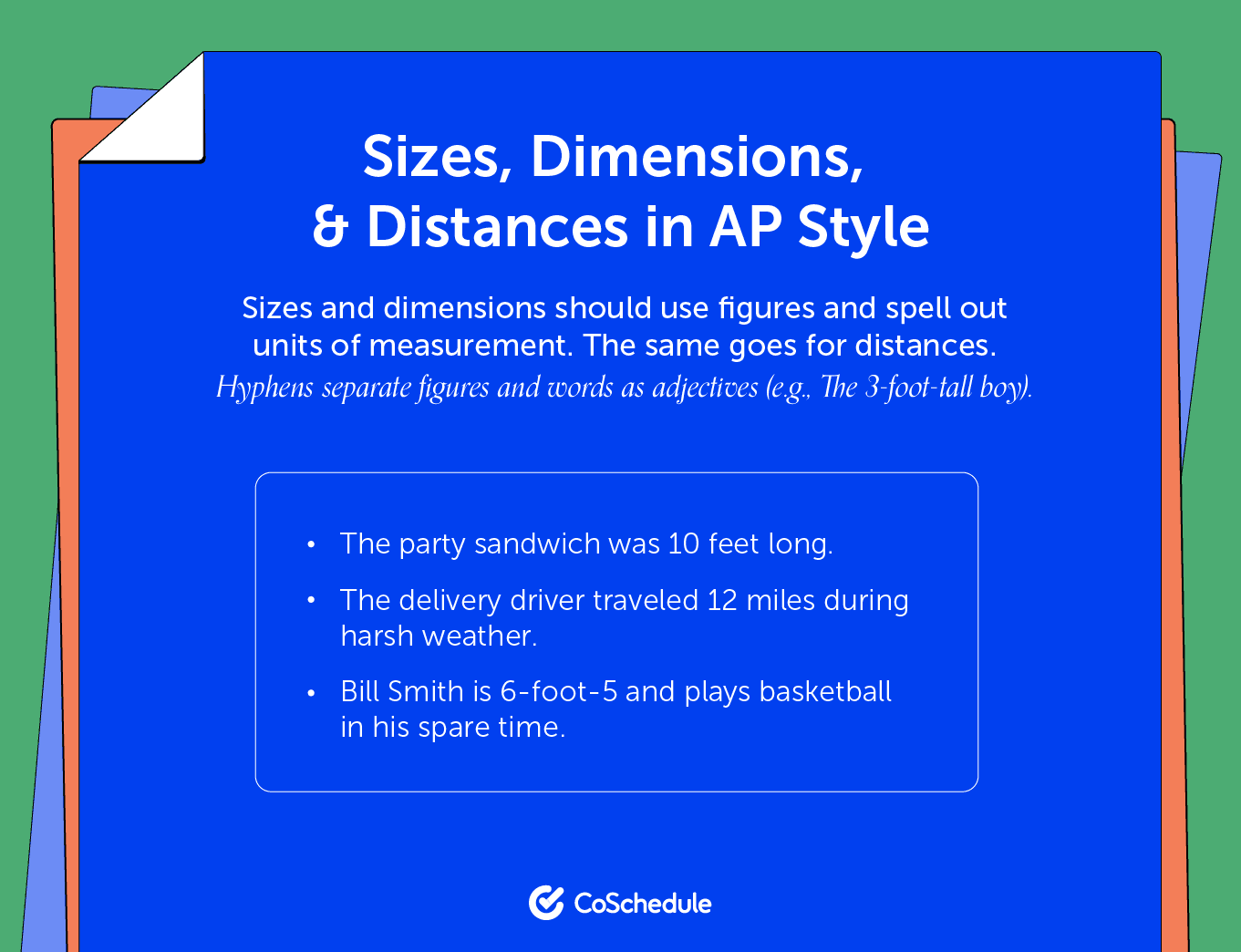
Percentages
Always use the entire word “percent” and avoid the % sign (e.g.,
The analyst predicted a 100 percent increase in site traffic).
Punctuation In AP Style
You learned everything you needed to know about punctuation in high school English class, right? Well, maybe or maybe not, but this style has its own quirks.
Single Space
Use a single space after a period (i.e., no double-spacing between sentences).
Serial Commas
Use commas to separate items in a list, but do not place a comma before the conjunction in most simple series (e.g., I need to buy milk, cheese, and bread). However, if omitting that final comma could lead to confusion, then include it for clarity.
Quotes & Quotations
How should you format quotes in AP Style?
- Periods and commas always go within quotation marks.
- Use single quotations for quotes within quotes.
Example: “The candy truck spilled all over the highway,” said the driver. “It’s a real ‘sticky situation’ on I-94.”
Hyphens
How can you use hyphens correctly with AP Style?
Use hyphens to connect words in compound adjectives (e.g., The larger-than-life performer juggled seven swords.).
Compound verbs also require hyphens (e.g., She spoon-fed the baby.).
En & Em Dashes
While sometimes used in other styles to indicate a range of time, AP Style does not use en dashes.
Em dashes, in contrast, are frequently used to signal an abrupt change, suggest a pause, or set off a clause within a sentence. AP refers to these simply as dashes and requires a space on either side.
Colons
Capitalize the first word after a colon only if it is a proper noun or the start of a complete sentence.
If used in combination with quotation marks, the colon should be placed on the outside unless part of the quotation itself.
Parentheses
Parentheses can awkwardly contort a sentence or appear jarring to the reader, so it’s often best to avoid them. That said, there are instances when parentheses insert helpful information, so if its use is necessary, follow these guidelines:
- Place a period outside the parentheses if the text inside is an incomplete sentence (such as this fragment).
- If the phrase in parentheses is a complete sentence but remains dependent on the surrounding material, do not capitalize the first word.
- Use parentheses if a state name or similar information is inserted within a proper name (e.g., The Newport (Rhode Island) Daily News).
Ellipses
When condensing a quote, piece of text, or document, use an ellipsis to indicate the deletion of one or more words. However, be cautious to avoid deletions that would distort the genuine meaning of the text.
You can also use an ellipsis to show a thought the writer did not complete.
Periods
Lean toward using periods in abbreviations where applicable (e.g., U.N., M.A., U.S.A.).
Exclamation Marks
Use an exclamation mark to express a high degree of amazement, disbelief, or other strong emotion. Avoid overuse by ending mildly exclamatory sentences in a period.
Question Marks
Place a question mark at the end of a direct question (e.g., Who is there?). Do not use a question mark to indicate the end of an indirect question (e.g., I want to know who is there.).
In a quotation, a question mark replaces the comma that typically comes before attribution (e.g., “Who started the protest?” She asked.).
Apostrophes
When proper and plural nouns end in an S, add an apostrophe at the end (e.g., Sally Jones’ red stapler has been stolen.)
Possessive singular nouns ending in S require an apostrophe before the S (e.g., The witness’s testimony).
Pronouns
When constructing a sentence, do not presume maleness or femaleness by defaulting to
he/his/him or
she/hers/her. Rewording the sentence to avoid gender is generally possible and preferred.
While
They/Them/Their is accepted as a gender-neutral pronoun, the singular use of
they can be unfamiliar. Use the person’s name in place of a pronoun or be clear in the phrasing to not imply more than one person.
Locations In AP Style
Addresses
How should you format an address in AP Style?
Always use figures for building numbers (e.g., 318 E. Broadway Ave.).
Denote directions following building numbers with N., E., S., W., but do not include periods for abbreviations such as NW (e.g., 1316 N. Sixth St. but 410 NW Eighth Ave.).
Spell out streetway numbers under ten. Use digits for numbers 10 and greater (e.g., 620 10th St. S.).
The only roadway abbreviations are St., Blvd., and Ave. only when following a numbered address (e.g., 318 First Ave., but The office is on First Avenue).
Abbreviate post office as P.O.
States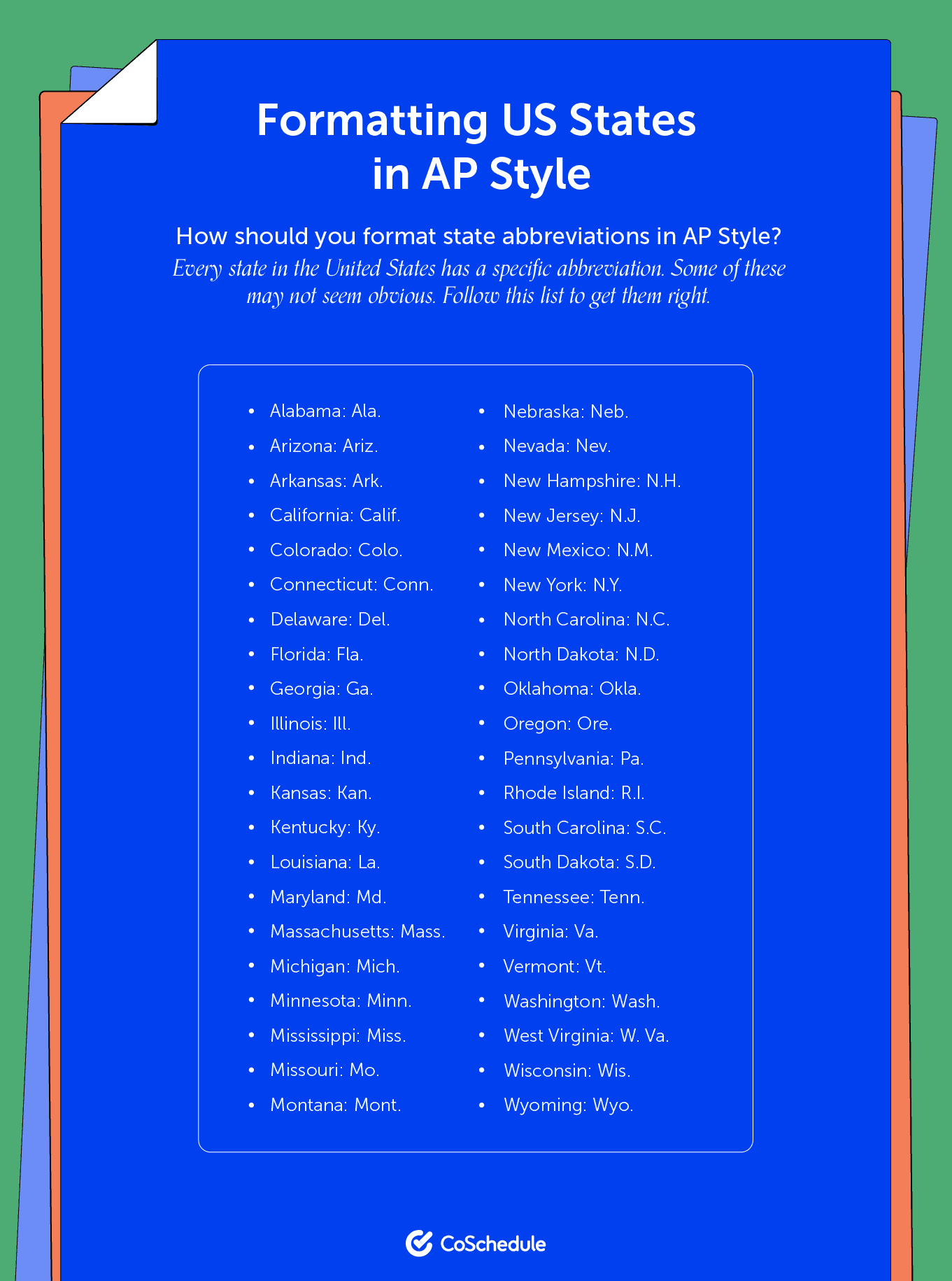
U.S. Cities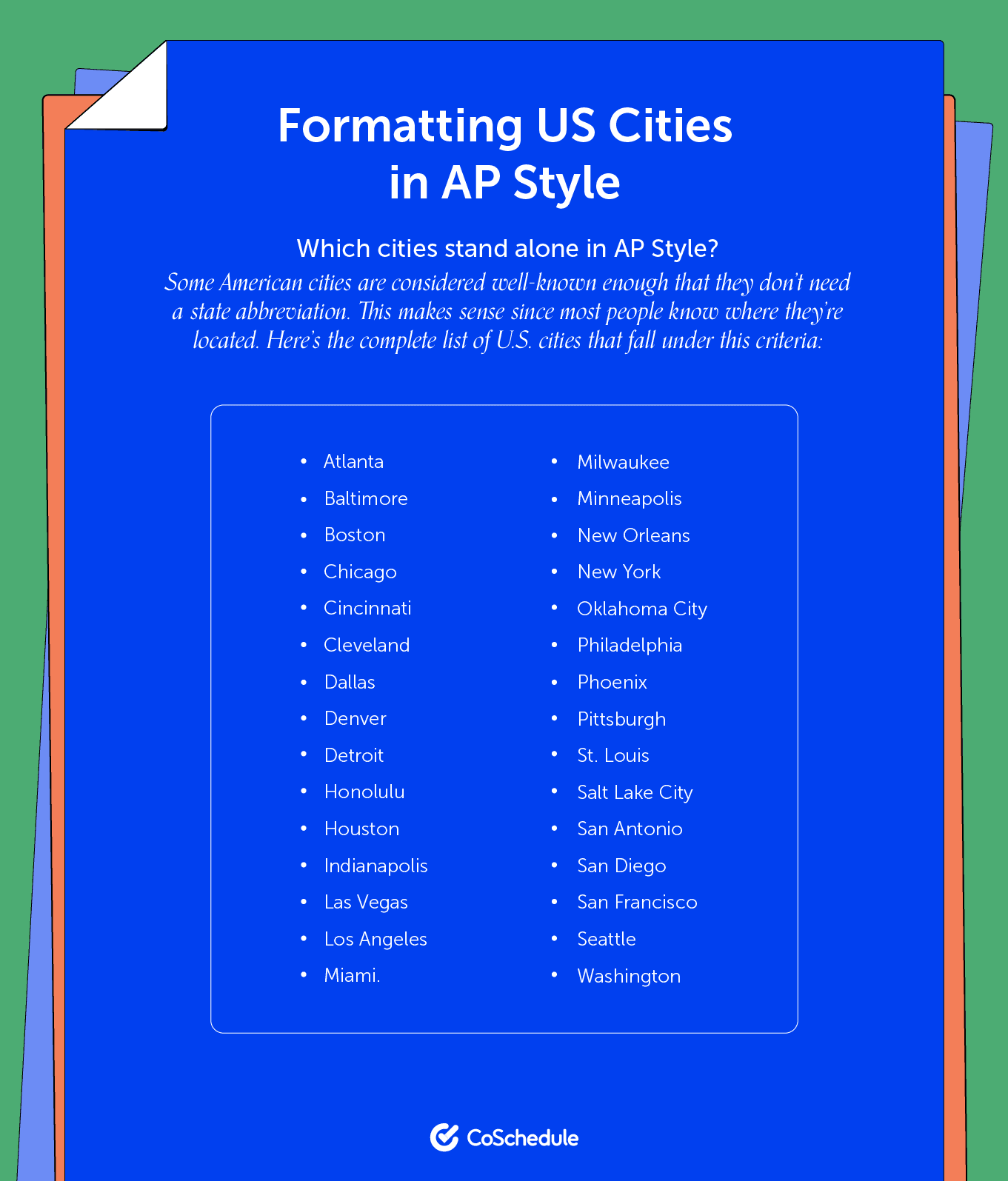
International Cities & Countries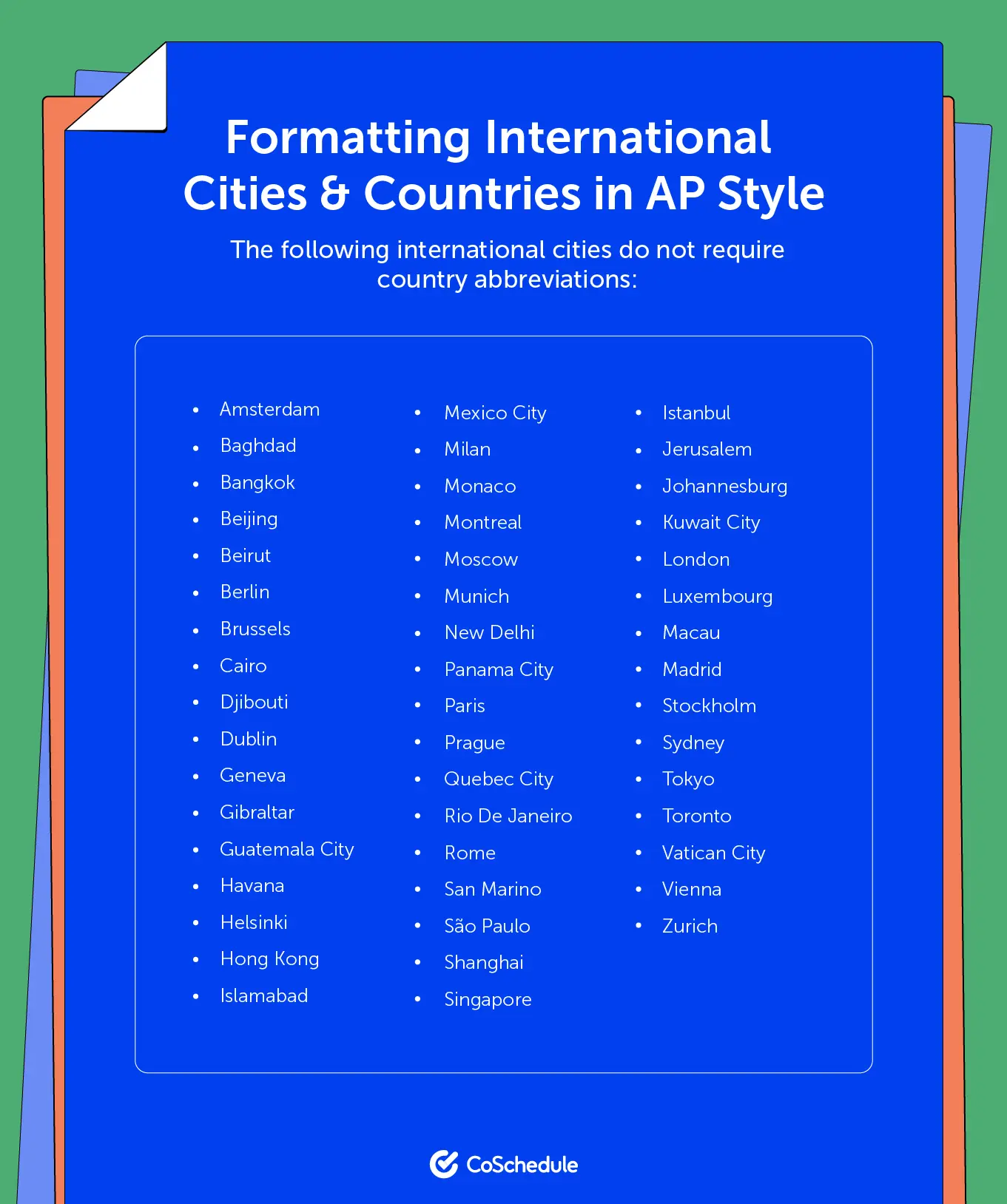
Headlines & Titles In AP Style
Article Headlines & Titles
A successful article headline must stand on its own, captivating the reader and providing essential details. To achieve this, follow these guidelines:
- AP headlines are limited to sixty characters; be creative in word choice
- Only the first word and proper nouns are capitalized. Exception: the first word after a colon is always capitalized
- Use single quotation marks
- Only use universally recognized abbreviations (e.g., US, EU, and UN) and avoid abbreviating state names
Composition Titles
Capitalize all words except articles, prepositions of three or fewer letters, and conjunctions of three or fewer letters.
Capitalize articles, prepositions, and conjunctions if they begin or end the piece's name.
Capitalize both words in phrasal verbs.
Capitalize to infinitives.
Place composition titles such as books, songs, movies, and speeches inside quotation marks.
Book Titles
Use quotation marks rather than italics (e.g., J.K. Rowling is the author of “Harry Potter and the Sorcerer's Stone.”).
Song Titles
Like all compositions, place song names within quotation marks (e.g., “Party in the USA” does not make me feel like partying.).
Movie Titles
Use quotation marks rather than italics. This may go against what likely feels right, and how you'd normally format them, but those are the rules. (e.g., The movie, "Harry Potter and the Sorcerer's Stone" was released in 2001.)
Newspaper Names
Use composition title capitalization but no quotation marks or italics (e.g., The Guardian is a well-respected newspaper.).
Magazine Names
Like newspaper names, magazine names are capitalized following the composition title guidelines (e.g., Wired is a popular magazine for tech enthusiasts.).
Website Names
Website names require composition title capitalization.
Software Titles
Capitalize system software names (e.g., Windows, Mac OS, Chrome OS, Android, etc.).
Job Titles
Capitalization is unnecessary if the title is informal, appears without a person’s name, follows a person’s name, or is set off before a name by commas.
Make sure your writing respects people’s formal titles. Some examples include political and medical titles. Follow these guidelines:
- Abbreviate political titles before full names outside direct quotes (e.g., Sen. Heidi Heitkamp, Gov. Doug Bergum, Rep. Kelly Armstrong).
- Medical titles follow a similar format (e.g., Dr. Michaela Quinn).
Title Suffixes
Abbreviate suffixes such as junior (e.g., Jeremiah Johnson, Jr.) and titles earned from degrees (e.g., James Newton, Ph.D.).
Organization Name Abbreviations & Acronyms
Use abbreviations for well-known organizations (e.g.,
FBI,
NASA,
IRS,
NFL,
MLB,
NHL,
FIFA).
For other organizations, spell it out on the first mention, then use abbreviations for subsequent mentions.
Use your best judgment. If people are unlikely to understand an abbreviation, then don’t use it.
Examples:
- The FBI agent was assigned the case.
- NASA announced plans to visit Mars.
- The MLB has not announced hot dog price restrictions for this year.
This piece was originally published on August 1, 2018. It was most recently updated in October of 2022. Clarity and consistency are the building blocks of great content.
When your writing is crisp, clear, and easy to understand, audiences will likely leave your site with a positive impression.
Unfortunately, many brands forego style guides and choose to wing it instead. While not necessarily a fatal mistake by any means, it does often lead to content that looks sloppy.
Without guidelines to enforce consistency, it’s easy to allow your content to become a formatting free-for-all where commas roam free, and nothing follows a clear logic. The results leave your blog or website looking at the Wild West of basic grammatical conventions.
If this sounds hyperbolic, consider this: newspapers are written to be effortless to read. Concise writing and consistent style go a long way toward achieving this goal. There’s a reason why your daily paper sounds how it does; it’s designed that way to be effective.
Does your content need to be perfect to be effective? Not nearly, no. But everything you can do to enforce consistency and clarity will help your cause. Here is a cheat sheet based on the updated 2023-2024 version of the Associated Press Stylebook.
Recommended: Website Citation Generator
Clarity and consistency are the building blocks of great content.
When your writing is crisp, clear, and easy to understand, audiences will likely leave your site with a positive impression.
Unfortunately, many brands forego style guides and choose to wing it instead. While not necessarily a fatal mistake by any means, it does often lead to content that looks sloppy.
Without guidelines to enforce consistency, it’s easy to allow your content to become a formatting free-for-all where commas roam free, and nothing follows a clear logic. The results leave your blog or website looking at the Wild West of basic grammatical conventions.
If this sounds hyperbolic, consider this: newspapers are written to be effortless to read. Concise writing and consistent style go a long way toward achieving this goal. There’s a reason why your daily paper sounds how it does; it’s designed that way to be effective.
Does your content need to be perfect to be effective? Not nearly, no. But everything you can do to enforce consistency and clarity will help your cause. Here is a cheat sheet based on the updated 2023-2024 version of the Associated Press Stylebook.
Recommended: Website Citation Generator










